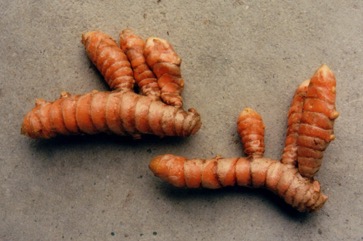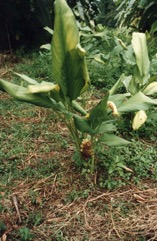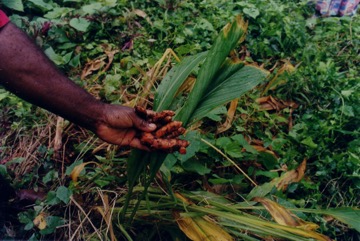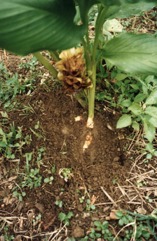Turmeric

It is a tropical plant. It is widespread in coastal areas up to 1000 m altitude in the Philippines. It needs a hot moist climate and a well drained soil. The soil needs to be loose for good rhizomes. Plants can grow in the shade but the yield is lower. Plants are drought and frost tender. It needs a temperature above 13°C. It suits hardiness zones 10-11. In Sichuan and Yunnan.
Also known as:
Afan, Ago, Aieng, Ang, Angai, Angorik, Ano, Arishina, Ath-kaha, Avea, Besar, Bola dimputu, Cago, Dilao, Dilaw, Eka, Ena, Geelwortel, Gingisy, Guchol, Gumnei, Halada, Haldee, Haldi, Hardi, Haridra, Holdi, Indian saffron, Jiang huang, Kaha, Kalabaga, Kamin, Kar-jio, Kari, Kaya haldi, Kesol, Khamin, Khamin chan, Khamin kaeng, Kharkoum, Kingondi, Kinur, Kisinioang, Koneng, Kuchin, Kulalo, Kunik, Kunir, Kunir bentis, Kunjit, Kunyit, Kurkum, Lea, Luyang dilaw, Mango, Manjal, Manjano, Manjanu, Mbilichira, Munjal, Nanwin, Ng-kiew, Nghe, Nieshe, Oang, Oangitik, Ochol, Ong, Pangao, Pasupu, Raga, Rea, Renet, Renga, Rerega, Romiet, Rormeat, Sa nwin, Shrynai, Silik di, Talea, Tamotamo, Temu glenyeh, Temu kuning, Temu kunyit, Terea, Tius, Tumeric, Ukon, Wanghuolong, Wong geung fun, Wong-keong, Wong kueng, Yangoshigm Yu-chin, Yung-ba, Yuquilla, Zholty Imbir
Synonyms
- Amomum curcuma Jacq.
- Curcuma brog Valeton
- Curcuma domestica Valeton
- Curcuma euchroma Valeton
- Curcuma ochrorhiza Valeton
- Curcuma soloensis Valeton
- Curcuma tinctoria Guibourt
- Kua domestica Medik. illeg.
- Stissera curcuma Giseke
- Stissera curcuma Raeusch.
Edible Portion
- Rhizome, Root, Leaves as condiment, Herb, Spice, Flowers
Where does Turmeric grow?
Found in: Africa, Andamans, Asia, Australia, Bangladesh, Belize, Bhutan, Bougainville, Brazil, Cambodia, Caribbean, China, Chuuk, Congo DR, Cook Islands, Costa Rica, Côte d'Ivoire, Cuba, East Africa, East Timor, Easter Island, Ethiopia, Fiji, FSM, Gambia, Guam, Guinea-Bissau, Hawaii, Himalayas, India, Indochina, Indonesia, Ivory Coast, Jamaica, Japan, Kiribati, Laos, Madagascar, Malawi, Malaysia, Maldives, Marianas, Marquesas, Mauritius, Micronesia, Mozambique, Myanmar, Nepal, New Caledonia, Northeastern India, Pacific, Pakistan, Palau, Papua New Guinea, PNG, Peru, Philippines, Pohnpei, Reunion, Rotuma, Samoa, Sao Tome and Principe, SE Asia, Sierra Leone, Sikkim, Slovenia, South America, Sri Lanka, St Lucia, Taiwan, Thailand, Tibet, Timor-Leste, Tonga, Uganda, United States, Vanuatu, Vietnam, Wallis & Futuna, West Africa, West Timor, Yap, Zambia
Notes: As Linnaeus used the wrong plant and Koenig used the right one it is recommended that Valeton's name be used. There are about 50 Curcuma species. They are mostly in SE Asia. It possibly has anti-cancer properties.
Status: It is a commercially cultivated vegetable. An important spice in rice eating cultures.
Growing Turmeric
Cultivation: Plants are normally grown from pieces of the rhizome. Pieces with one or two buds are used. Larger side tubers are best. They are planted 6-8 cm deep. The distance between plants needs to be 30-40 cm. They can also be grown from seed where these occur. The roots are harvested as the leaves start to die back.
Edible Uses: The orange coloured rhizome is used as seasoning especially in curry. They are also used for food colouring. They can be used fresh or boiled and dried. The young shoots are also eaten. The flowers are roasted or fried and eaten.
Production: Leaves appear above ground in about 4 weeks. The crop is harvested in about 9-10 months when the lower leaves turn yellow. When the roots are harvested they are put in boiling water for an hour. This assists drying and avoids sprouting. They are then dried in the sun. The outer layer is removed by rubbing.
Nutrition Info
per 100g edible portion| Edible Part | Energy (kcal) | Protein (g) | Iron (mg) | Vitamin A (ug) | Vitamin c (mg) | Zinc (mg) | % Water |
|---|---|---|---|---|---|---|---|
| Rhizome dried | 353 | 7.8 | 41.4 | 0 | 25.9 | 4.4 | 11.4 |
| Roots fresh | 46 | 1.2 | 2.3 | - | - | - | 88.2 |
Turmeric Photos




References
Alegado, A. M. & De Guzman, R. B., 2014, Indigenous food crops of the Aetas tribe in the Philippines and their traditional methods of food preparation. in Promotion of Underutilized Indigenous Food Resources for Food Security and Nutrition in Asia and Pacific. FAO. Bangkok p 160 (As Curcuma domestica)
Ali, A. M. S., 2005, Homegardens in Smallholder Farming Systems: Examples from Bangladesh. Human Ecology, Vol. 33, No. 2 pp. 245-270
Ambasta, S.P. (Ed.), 2000, The Useful Plants of India. CSIR India. p 152
Anderson, E. F., 1993, Plants and people of the Golden Triangle. Dioscorides Press. p 208 (As Curcuma domestica)
Barrau, J., 1976, Subsistence Agriculture in Polynesia and Micronesia. Bernice P. Bishop Museu, Bulletin 223 Honolulu Hawaii. Kraus reprint. p 60
Bodkin, F., 1991, Encyclopedia Botanica. Cornstalk publishing, p 308
Bourret, D., 1981, Bonnes-Plantes de Nouvelle-Caledonie et des Loyaute. ORSTOM. p 57
Bremness, L., 1994, Herbs. Collins Eyewitness Handbooks. Harper Collins. p 163 (As Curcuma longa)
Brouk, B., 1975, Plants Consumed by Man. Academic Press, London. p 266, 331 (As Curcuma longa)
Brown, D., 2002, The Royal Horticultural Society encyclopedia of Herbs and their uses. DK Books. p 186 (As Curcuma longa)
Brown, W.H., 1920, Wild Food Plants of the Philippines. Bureau of Forestry Bulletin No. 21 Manila. p 37 (As Curcuma longa)
Bull. Jard. Bot. Buitenzorg ser. 2, 27:31. 1918
Burkill, H. M., 1985, The useful plants of west tropical Africa, Vol. 5. Kew.
Burkill, I.H., 1966, A Dictionary of the Economic Products of the Malay Peninsula. Ministry of Agriculture and Cooperatives, Kuala Lumpur, Malaysia. Vol 1 (A-H) p 716
Call, C. A., et al, 2004, Participatory Rural Appraisal in the Upland Ecosystem of Mt Malindang, Misamis Occidental, Philippines. Biodiversity Research Programme for Development in Mindanao. p 62
Cheifetz, A., (ed), 1999, 500 popular vegetables, herbs, fruits and nuts for Australian Gardeners. Random House p 123
Chin, H. F., 1999, Malaysian Vegetables in Colour. Tropical Press. p 89
Cobley, L.S. (rev. Steele, W.M.) 2nd Ed., 1976, An Introduction to the Botany of Tropical Crops. Longmans. p 232
Cundall, P., (ed.), 2004, Gardening Australia: flora: the gardener's bible. ABC Books. p 447 (As Curcuma longa)
Dhyani, S.K., & Sharma, R.V., 1987, Exploration of Socio-economic plant resources of Vyasi Valley in Tehri Garwhal. J. Econ. Tax. Bot. Vol. 9 No. 2 pp 299-310
Esperanca, M. J., 1988. Surviving in the wild. A glance at the wild plants and their uses. Vol. 2. p 294
Facciola, S., 1998, Cornucopia 2: a Source Book of Edible Plants. Kampong Publications, p 248
Foo, J.T.S.(ed), 1996, A Guide to Common Vegetables. Singapore Science Foundation. p 149
Fowler, D. G., 2007, Zambian Plants: Their Vernacular Names and Uses. Kew. p 74 (As Curcuma domestica)
Franklin, J., Keppel, G., & Whistler, W., 2008, The vegetation and flora of Lakeba, Nayau and Aiwa Islands, Central Lau Group, Fiji. Micronesica 40(1/2): 169–225, 2008
French, B.R., 1986, Food Plants of Papua New Guinea, A Compendium. Asia Pacific Science Foundation p 338
French, B.R., 2010, Food Plants of Solomon Islands. A Compendium. Food Plants International Inc. p 315 (As Curcuma domestica)
Gangte, H. E., et al, 2013, Wild Edible Plants used by the Zou Tribe in Manipur, India. International Journal of Scientific and Research Publications, Volume 3, Issue 5
Guite, C., 2016, A study of wild edible plants associated with the Paite tribe of Manipur, India, International Journal of Current Research. Vol. 8, Issue, 11, pp. 40927-40932
Hani Medicine of Xishuangbanna, 1999, p 439 (As Curcuma longa)
Hedrick, U.P., 1919, (Ed.), Sturtevant's edible plants of the world. p 254
Heywood, V.H., Brummitt, R.K., Culham, A., and Seberg, O., 2007, Flowering Plant Families of the World. Royal Botanical Gardens, Kew. p 409
Hemphill, I, 2002, Spice Notes. Macmillan. p 396
Hibbert, M., 2002, The Aussie Plant Finder 2002, Florilegium. p 78
Hutton, W., 1997, Tropical Herbs and Spices of Indonesia. Periplus. p 57
Hu, Shiu-ying, 2005, Food Plants of China. The Chinese University Press. p 327 (As Curcuma domestica)
Jacquat, C., 1990, Plants from the Markets of Thailand. D.K. Book House p 116
Jansen, P.C.M., 2005. Curcuma longa L. [Internet] Record from Protabase. Jansen, P.C.M. & Cardon, D. (Editors). PROTA (Plant Resources of Tropical Africa), Wageningen, Netherlands. < http://database.prota.org/search.htm>. Accessed 15 October 2009.
Japanese International Research Centre for Agricultural Science www.jircas.affrc.go.jp/project/value_addition/Vegetables
Johnson, N., 2002, Environmental Change in northern Thailand: Impact on Wild Edible Plant Availability. Ecology of Food and Nutrition, 41: 5, 373-399
Kays, S. J., and Dias, J. C. S., 1995, Common Names of Commercially Cultivated Vegetables of the World in 15 languages. Economic Botany, Vol. 49, No. 2, pp. 115-152
Khodram,S. D., et al, 2019, Local knowledge of edible flowers used in Mizoram. Indian Journal of Traditional Knowledge Vol 18(40 pp 715-723
Kiple, K.F. & Ornelas, K.C., (eds), 2000, The Cambridge World History of Food. CUP p 434 (As Curcuma longa), p 1873
Kuo, W. H. J., (Ed.) Taiwan's Ethnobotanical Database (1900-2000), http://tk.agron.ntu.edu.tw/ethnobot/DB1.htm
Kybal, J., 1980, Herbs and Spices, A Hamlyn Colour Guide, Hamlyn Sydney p 90
Lamont, S.R., et al, 1999, Species composition, and use of Homegardens among three Amazonian Villages. Economic Botany 53(3) pp 312-326
Larsen, K., Ibrahim, H., Khaw, S.H., & Saw, L.G., 1999, Gingers of Peninsula Malaysia and Singapore. Natural History Publications (Borneo). p 44
Latham, P., 2004, Useful Plants of Bas-Congo province. Salvation Army & DFID p 103
Lazarides, M. & Hince, B., 1993, Handbook of Economic Plants of Australia, CSIRO. p 70 (As Curcuma longa)
Lembaga Biologi Nasional, 1977, Ubi-Ubian, Balai Pustaka, Jakarta. p 52
Lembaga Biologi Nasional, 1977, Ubi-Ubian, Balai Pustaka, Jakarta. p 78 (As Curcuma soloensis)
Liefting, A., et al, Samoan plant names. http://en.wikipedia.org
Lim, T. K., 2015, Edible Medicinal and Non Medicinal Plants. Volume 9, Modified Stems, Roots, Bulbs. Springer p 30
Malaisse, F., 1997, Se nourrir en floret claire africaine. Approche ecologique et nutritionnelle. CTA., p 61
Manandhar, N.P., 2002, Plants and People of Nepal. Timber Press. Portland, Oregon. p 181
Marinelli, J. (Ed), 2004, Plant. DK. p 232
Martin, F.W. & Ruberte, R.M., 1979, Edible Leaves of the Tropics. Antillian College Press, Mayaguez, Puerto Rico. p 98
Martin, F.W. & Ruberte, R.M., 1979, Edible Leaves of the Tropics. Antillian College Press, Mayaguez, Puerto Rico. p 225
McMakin, P.D., 2000, Flowering Plants of Thailand. A Field Guide. White Lotus. p 40
Medhi, P. & Borthakur, S. K., 2012, Phytoresources from North Cachur Hills of Assam -3: Edible plants sold at Hflong market. Indian Journal of Natural Products and Resources. 3(1) pp 84-109 (As Curcuma domestica)
Molla, A., Ethiopian Plant Names. http://www.ethiopic.com/aplants.htm
Mulherin, J., 1994, Spices and natural flavourings. Tiger Books, London. p 92
Murakami, A. et al, 2014, Screening for the In Vitro Anti-tumor-promoting Activities of Edible Plants from Malaysia. Bioscience, Biotechnology, and Biochemistry, 64:1, 9-16. (As Curcuma domestica)
Murtem, G. & Chaudhrey, P., 2016, An ethnobotanical note on wild edible plants of Upper Eastern Himalaya, India. Brazilian Journal of Biological Sciences, 2016, v. 3, no. 5, p. 63-81
Niwano, Y. et al., 2009, Extensive Screening for Plant Foodstuffs in Okinawa, Japan with Anti-Obese Activity on Adipocytes, in vitro. Plant Foods in Human Nutrition 64:6-10
Norrington, L., & Campbell, C., 2001, Tropical Food Gardens. Bloomings Books. p 75
Ochse, J. J. et al, 1931, Vegetables of the Dutch East Indies. Asher reprint. p 736
Ojelel, S., et al, 2019, Wild edible plants used by communities in and around selected forest reserves of Teso-Karamoja region, Uganda. Journal of Ethnobiology and Ethnomedicine (2019) 15:3
Owen, S., 1993, Indonesian Food and Cookery, INDIRA reprints. p 70
Peekel, P.G., 1984, (Translation E.E.Henty), Flora of the Bismarck Archipelago for Naturalists, Division of Botany, Lae, PNG. p 109, 108 (As Curcuma longa)
Phon, P., 2000, Plants used in Cambodia. © Pauline Dy Phon, Phnom Penh, Cambodia. p 184
Powell, J.M., Ethnobotany. In Paijmans, K., 1976, New Guinea Vegetation. Australian National University Press. p 109
Priyadi, H., et al, Five hundred plant species in Gunung Halimun Salak National Park West Java. A checklist including Sundanese names, distribution and use. CIFOR, FFPRI, SLU p 121 (As Curcuma domestica)
PROSEA (Plant Resources of South East Asia) handbook, Volume 13, 1999, Herbs and spices
Purseglove, J.W., 1972, Tropical Crops. Monocotyledons. Longmans p 522
Rajapaksha, U., 1998, Traditional Food Plants in Sri Lanka. HARTI, Sri Lanka. p 505 (As Curcuma domestica)
Rashid, H. E., 1977, Geography of Bangladesh. Westview. p 280
Recher, P, 2001, Fruit Spirit Botanical Gardens Plant Index. www.nrg.com.au/~recher/ seedlist.html p 4
Sawian, J. T., et al, 2007, Wild edible plants of Meghalaya, North-east India. Natural Product Radiance Vol. 6(5): p 415
Seidemann J., 2005, World Spice Plants. Economic Usage, Botany, Taxonomy. Springer. p 126
Sirirugsa, P., 1999, Thai Zingiberaceae: Species Diversity and their Uses. http://www.iupac.org/symposia/roceedings/phuket 97
Smith, A.C., 1979, Flora Vitiensis Nova, Lawaii, Kuai, Hawaii, Volume 1 p 196
Smith, P.M., 1979, Turmeric, in Simmonds, N.W., (ed), Crop Plant Evolution. Longmans. London. p 322
Solomon, C., 2001, Encyclopedia of Asian Food. New Holland. p 390
Staples, G.W. and Herbst, D.R., 2005, A tropical Garden Flora. Bishop Museum Press, Honolulu, Hawaii. p 763
Sukarya, D. G., (Ed.) 2013, 3,500 Plant Species of the Botanic Gardens of Indonesia. LIPI p 1097
Sukenti, K., et al, 2016, Ethnobotanical study on local cuisine of the Sasak tribe in Lombok Island, Indonesia. Journal of Ethnic Foods. 3 (2016) 189-200 p 198 (As Curcuma domestica)
Terra, G.J.A., 1973, Tropical Vegetables. Communication 54e Royal Tropical Institute, Amsterdam, p 42
Thaman, R.R., 1976, The Tongan Agricultural System, University of the South Pacific, Suva, Fiji. p 393
Thaman, R. R., 1987, Plants of Kiribati: A listing and analysis of vernacular names. Atoll Research Bulletin No. 296
Thokchom, R., et al, 2016, Documentation and assessment of wild medicinal and edible flowers of valley districts of Manipur. International Journal of Research in Applied, Natural and Social Sciences. 4(11):13-20
Turreira Garcia, N., et al, 2017, Ethnobotanical knowledgeof the Kuy and Khmer people in Prey Lang, Cambodia. Cambodian Journal of Natural History 2017 (1): 76-101
Tyagi, R. K., et al, 2004, Conservation of Spices Germplasm in India. Indian J. Plant Genet. Resour. 17(3): 163-174
Van Sam, H. et al, 2008, Uses and Conservation of Plant Species in a National Park. A case study of Ben En, Vietnam. Economic Botany 62:574-593
van Wyk, B., 2005, Food Plants of the World. An illustrated guide. Timber press. p 164
Vickery, M.L. and Vickery, B., 1979, Plant Products of Tropical Africa, Macmillan. p 87 (As Curcuma longa)
Walter, A. & Lebot, V., 2007, Gardens of Oceania. ACIAR Monograph No. 122. p 265
Williams, C.N., Chew, W.Y., and Rajaratnam, J.A., 1989, Tree and Field Crops of the Wetter Regions of the Tropics. Longman, p 231
Williamson, J., 2005, Useful Plants of Malawi. 3rd. Edition. Mdadzi Book Trust. p 91
Woodward, P., 2000, Asian Herbs and Vegetables. Hyland House. p 62 (As Curcuma longa)
World Checklist of Useful Plant Species 2020. Royal Botanic Gardens, Kew
Wu Delin, Larsen, K., Zingiberaceae. Flora of China. (As Curcuma longa)
Xu, You-Kai, et al, 2004, Wild Vegetable Resources and Market Survey in Xishuangbanna, Southwest China. Economic Botany. 58(4): 647-667.
Yeshi, K. et al, 2017, Taxonomical Identification of Himalayan Edible Medicinal Plants in Bhutan and the Phenolic Contents and Antioxidant Activity of Selected Plants. TBAP 7 (2) 2017 pp 89 - 106
Yuncker, T.G., 1959, Plants of Tonga, Bernice P. Bishop Museum, Hawaii, Bulletin 220. p 86 (As Curcuma longa)
Zizka, G., 1991, Flowering Plants of Easter Island. Palmarum Hortus Francofurtensis